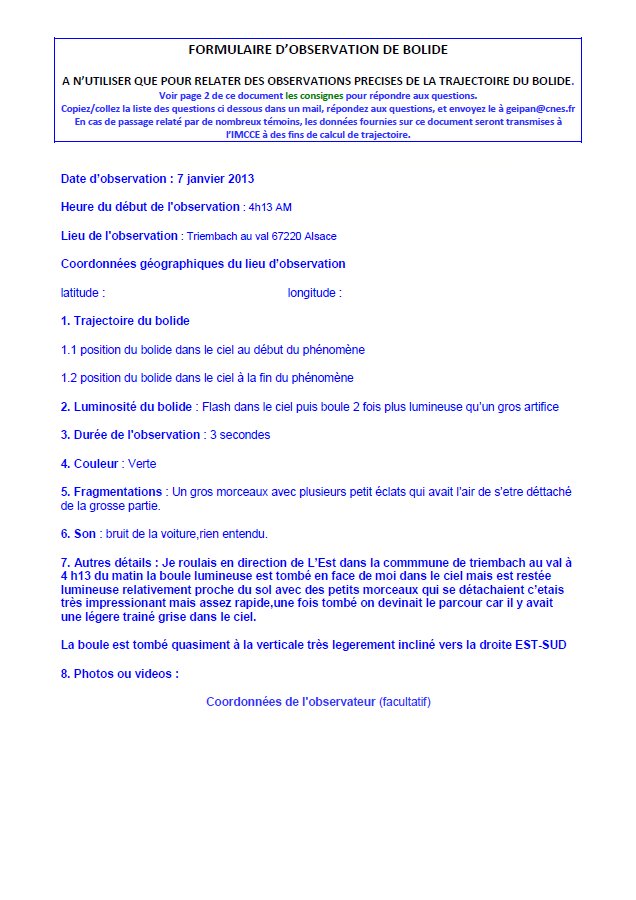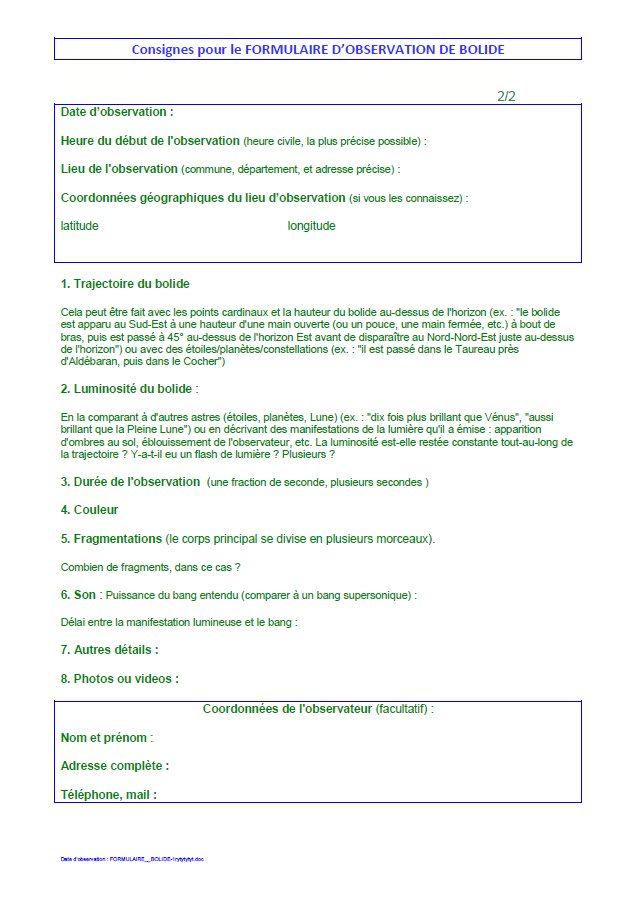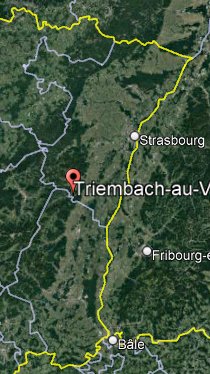ALSACAT-2013-01-07-TRIEMBACHAUVAL-1
A man reported to the official service GEIPAN, using their meteor observation report form, that on January 7, 2013, at 4:13 a.m., he observed from his car that he drove eastward passing in Triembach-au-Val, a green flash in the sky, then a ball twice as bright "a big fireworks", in front of him, so to the East.
There was fragmentation: "a big chunk with several small chips that seemed to have detached from the big part."
He does not know if there was sound, because of his car's noise; In any case, he did not hear a sound from the phenomenon.
He specified that the luminous ball fell in front of him in the sky, "almost vertically very slightly inclined to the right east-south", "but remained luminous relatively close to the ground with small pieces that stood out." It was very impressive but fast enough, once fallen one guessed its trajectory because there was a slight gray trail in the sky."
The observation lasted 3 seconds.
| Date: | January 7, 2013 |
|---|---|
| Time: | 04:13 a.m. |
| Duration: | 3 seconds. |
| First known report date: | 2014? |
| Reporting delay: | Day, months. |
| Department: | Bas-Rhin |
|---|---|
| City: | Triembach-au-Val |
| Place: | Driving in car, UFO in the sky. |
| Latitude: | 48.337 |
| Longitude: | 7.323 |
| Uncertainty radius: | 3 km |
| Number of alleged witnesses: | 1 |
|---|---|
| Number of known witnesses: | 1 |
| Number of named witnesses: | 0 to 1 |
| Witness(es) ages: | Young adult, adult or aged. |
| Witness(es) types: | Male. |
| Reporting channel: | By GEIPAM meteor sighting report form. |
|---|---|
| Type of location: | Driving in car, UFO in the sky. |
| Visibility conditions: | Night, cloud cover except in direction of UFO. |
| UFO observed: | Yes |
| UFO arrival observed: | ? |
| UFO departure observed: | Yes |
| Entities: | No |
| Photographs: | No. |
| Sketch(s) by witness(es): | No. |
| Sketch(es) approved by witness(es): | No. |
| Witness(es) feelings: | ? |
| Witnesses interpretation: | Meteor. |
| Hynek: | NL |
|---|---|
| ALSACAT: | Negative, pProbable meteor. |
[Ref. ge1:] GROUPE D'ETUDES ET D'INFORMATIONS SUR LES PHENOMENES AEROSPATIAUX NON IDENTIFIES (G.E.I.P.A.N.):
TRIEMBACH-AU-VAL (67) 01/07/2013 |
|
| Observed on: | 01/072013 |
| Region: | Alsace |
| Department: | Rhin (Bas) |
| Class: | B |
| Summary: | TRIEMBACH-AU-VAL (67) 01/07/2013. Observation during 3 secondes of a flash in the sky followed by a ball from which several parts detach: probable observation of the re-entry in the atmosphere of a meteoroid. |
| Description: |
On January 7, 2013, at 4:13 a motorist observed for 3 seconds a flash in the sky followed by a ball from which several fragments detached. No other testimony was be collected. The description of the witness corresponds quite to the appearance of a bolide (re-entry in the atmosphere of meteoroid). January 7th is the end of the swarm of shooting stars of the Quadrantids. At the time of the observation, the sky was very overcast on the whole of France, except in the South-East; the sky was a little less loaded in Germany, in the direction in which the witness was watching. The very early hour probably explains the uniqueness of the testimony. This phenomenon has had more opportunities to be observed in Germany than in France. There is no recording in the BOAM database, probably due to cloud cover. We note the same day, but at 11:45 p.m., a big bolide on the center of France (see the case SAINT-ETIENNE-DE-BOULOGNE (07) 01/072013). GEIPAN classes this case "B": probable observation of a bolide (return to the atmosphere of a meteoroid). |
| Report: | None. |
Details of the testimony |
|
| Witness | |
| Date of the observation | 01/07/2013 |
| Document number | |
| Age | Not specified |
| Profession | Not-specified |
| Sex | Male |
| Reaction | Passive Curiosity |
| Credibility | |
| Conditions | |
| Environment | Departmental paths,Roads |
| Weather conditions | Not-specified |
| Hour of the observation | Numbered: 4 - 6 o'clock |
| Reference frame | Sky or clouds |
| Distance between phenomenon and witness | Not-specified |
| Start of the observation | Start of observation by witness |
| End of the observation | Not defined |
| Localization | |
| Angle of the site | Non-specified |
| Direction d'observation | East |
| Heading | East |
| Trajectory | Descending; Descending |
| Nature of the observation | Descriptive terms (lights, etc) |
| Characteristic of the observation | With trail, tail, sparkles, beam |
| Global shape | Beam; Round, circular, ball; Round, |
| Color | Green |
| Apparent size | Not-specified |
| Apparent speed | Fast, great, quick |
| Noise | Not-specified |
| Effect on the environment | Not-specified |
| Number | 1 |

|
|
Observation Date: January 7, 2013 Time of the observation: 4:13 a.m. Location of observation: Triembach au val 67220 Alsace Geographical coordinates of the observation site longitude latitude: 1. Trajectory of the bolide 1.1 position of the bolide in the sky at the beginning of the phenomenon 1.2 position of the bolide in the sky at the end of the phenomenon 2. Brightness of the bolide: Flash in the sky then ball 2 times brighter than a big firework 3. Duration of observation: 3 seconds 4. Color: Green 5. Fragmentations: A large piece with several small chips that seemed to have detached from the big part. 6. Sound: car noise, nothing heard. 7. Other details: I was driving towards the East in the triembach au Val village at 4:13 in the morning the luminous ball fell in front of me in the sky but remained luminous relatively close to the ground with small pieces that detached It was very impressive but quite fast, once fallen one guessed the course because there was a slight gray trail in the sky. The ball fell almost vertically very slightly sloping to the right EAST-SOUTH 8. Photos or videos: Observer contact information (optional) |

|
|
2/2 1. Trajectory of the bolide This can be done with the cardinal points and the height of the bolide above the horizon (eg: "the bolide appeared in the Southeast at a height of an open hand (or an inch, a closed hand, etc.) at arm's length, then rose to 45° above the eastern horizon before disappearing to the North-North-East just above the horizon ") or with stars / planets / constellations ( eg: "it passed in the Bull near Aldebaran, then in the Big Dipper") 2. Brightness of the bolide: Comparing it to other stars (stars, planets, moon) (eg "ten times brighter than Venus", "as bright as the Full Moon") or describing manifestations of the light it emitted: appearance of shadows on the ground, dazzling of the observer, etc. Did luminosity remained constant all along the trajectory? Was there a flash of light? Many? 3. Duration of the observation (a fraction of a second, several seconds) 4. Color 5. Fragmentation (the main body divided into several pieces). How many fragments, in this case? 6. Sound: Power of the heard bang (compare to a sonic boom): Time between the luminous manifestation and the bang: 7. Other details: 8. Photos or videos: Observation date: FORM__BOLIDE-1rytytytyt.doc |

|
It is probably the final explosion of a meteor that was observed.
I did not find any other meteor report that would confirm this one, but the brevity, the early hour, and the cloud cover indicated by GEIPAN explain this.
Since the witness is using GEIPAN's "meteor" form, one can consider that he never thought it would be anything else, so we have what we call a "negative case", an observation that the witness himself explained.
On a sidenote, I do not understand why the term "re-entry" is used fro meteors. Meteors do not return, it should not be called a "re-entry" but an entry.
Negative, probable meteor.
* = Source is available to me.
? = Source I am told about but could not get so far. Help needed.
| Main author: | Patrick Gross |
|---|---|
| Contributors: | None |
| Reviewers: | None |
| Editor: | Patrick Gross |
| Version: | Create/changed by: | Date: | Description: |
|---|---|---|---|
| 0.1 | Patrick Gross | June 7, 2018 | Creation, [ge1]. |
| 1.0 | Patrick Gross | June 7, 2018 | First published. |